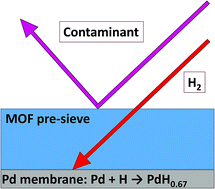Contaminant-resistant MOF–Pd composite for H2 separation†
Abstract
The drive to use hydrogen as energy carrier or reducing agent to synthesise hydrocarbons boosts its demand, requiring affordable and reliable separation methods. In this work, the combination of a selective but vulnerable Pd thin film with a robust metal–organic framework (MOF) yielding a contaminant-resistant composite membrane for hydrogen separation is reported.


 Please wait while we load your content...
Please wait while we load your content...